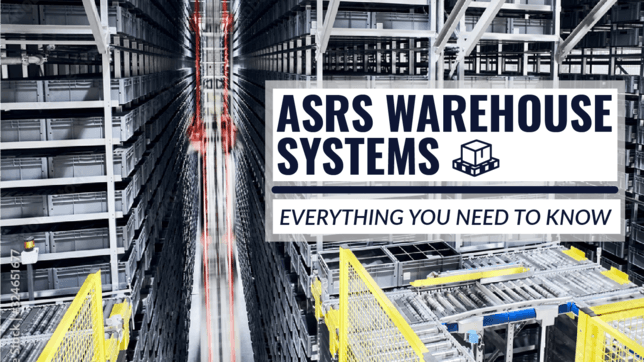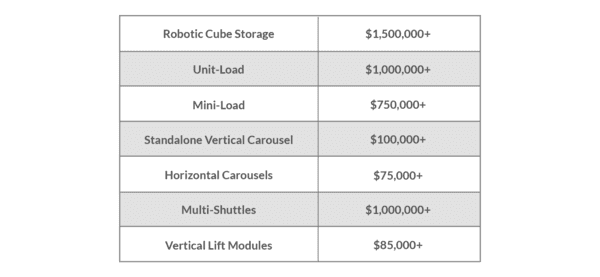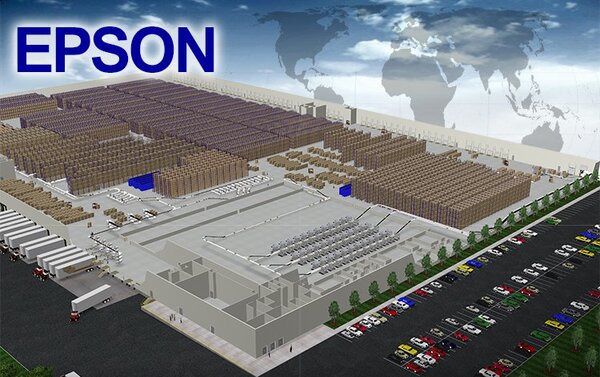This article is all about ASRS warehouse systems.
In it, you’ll learn:
- What ASRS systems are and their history
- The different types of ASRS systems and how they work
- The benefits of ASRS systems
- What companies use ASRS systems
- And much more!
Let’s dive in!
What Is ASRS?
The first question to answer is: What does ASRS stand for?
Answer: “Automated storage and retrieval systems.”
Now that we got that out of the way, what is an automated storage and retrieval system?
They are systems designed to automatically put materials into storage or retrieve them for order fulfillment.
ASRS Definition
ASRS systems (sometimes styled AS/RS) are warehouse automation technology that augments or replaces manual warehousing tasks.
Such tasks can include placing items or picking them from storage.
Automated Storage and Retrieval Systems: A History
Let’s go through the history of ASRS systems to give you the full context for what they are and what they do.
ASRS Versus The Traditional Warehouse System
Before ASRS systems were developed, companies had to manually handle all aspects of warehousing and distribution.
And over time, this led to many challenges.
Some of the challenges for traditional warehouses included:
-
Warehouses were wide-open and storage was spread out, which didn’t make good use of the space
-
As demand picked up, warehouses had to handle greater quantities of goods
-
The way inventory was stored didn’t lend itself to the process of demand-oriented flow and picking
As a result, orders took longer to fulfill.
And more human labor was required to fulfill them.
The Introduction of ASRS Technology
Then in 1962, ASRS systems were developed by the engineers at Demag – now known as Dematics.
These early systems consisted of mobile masts and reach trucks.
This equipment was able to move up and down storage racking while placing and retrieving items from within.
As a result of the development of ASRS systems, warehouse management was revolutionized because warehouses could now:
-
Make storage racking taller to increase storage density
-
Minimize errors by retrieving the right inventory, at the right time, and bringing it to the right place
-
Improve throughput by reducing the reliance on manual labor for order fulfillment
Additionally, ASRS systems meant that warehouses could now be smaller, more closed, and take up less space.
ASRS Developments in Recent Decades
After 1962, ASRS systems and technology continued to grow.
By the 1980s, companies began to refer to ASRS facilities as high-bay warehouses.
This was due to the increasing storage heights, which could extend up to 150 feet.
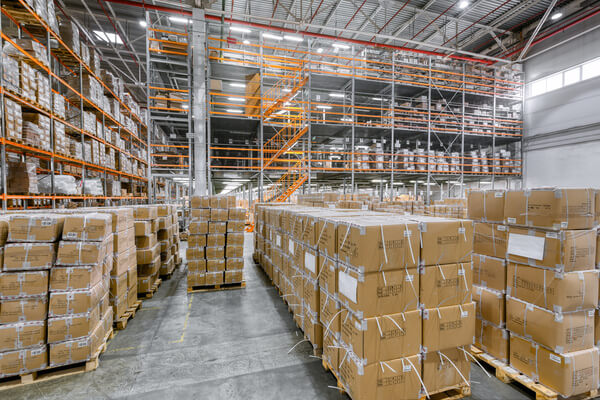
New ASRS machines were also developed that could switch from aisle to aisle.
Furthermore, expanded computer and IT technology in the 1990s and beyond allowed for the development of sensors, lasers, and magnets.
These were used to help measure distance and positions with precision.
As a result, ASRS automation could reach more material, precisely, resulting in even greater productivity, fewer errors, and less reliance on manual labor.
The Future of ASRS
So far into the 21st century, ASRS innovations continue to improve with more technological advancements that seek to:
-
Reduce overall ASRS weight with new construction materials
-
Increase energy efficiency, recovery, and reuse
-
Avoid energy peaks with software-controlled startup timing
-
Improve safety at greater heights with systems designed to offset the potential of mast sway
-
Increase ASRS system longevity by replacing wear-prone components with longer-lasting parts
How Does An ASRS System Work?
ASRS systems in warehouses use two types of technology to function:
-
Software systems, like warehouse execution software (WES) and warehouse management software (WMS)
-
Material handling equipment, like cranes, conveyors, and robotic shuttles
Working together, these systems help streamline scheduling, storing and retrieving warehouse items, and tracking inventory.
Now, we’ve covered warehousing software systems in our article on Warehouse Automation Trends.
So we’ll skip that topic here.
But let’s go through the various types of ASRS equipment so you understand exactly how these systems work.
What Are the Types of Automated Storage and Retrieval Systems?
There are two main types of ASRS systems:
- Unit-load
- Mini-load
Let’s cover the difference between them.
1. Unit-Load ASRS
Unit-load ASRS systems are designed to handle large and heavy pallets and cases, with weights ranging from 1,000 to 5,500 lbs.
This type of ASRS is ideal where there’s limited pallet-level storage and when quick retrieval is critical.

To function, unit-load ASRS systems use narrow aisle racking and a crane, which can extend to heights greater than 100 feet.
And when it comes to ASRS cranes, there are 2 types:
- Fixed-aisle cranes
- Moveable aisle cranes
Let’s discuss what each is.
Fixed-Aisle Cranes
Fixed-aisle ASRS cranes consist of a crane installed in a warehouse aisle.
The crane moves along the ASRS rack system – horizontally and vertically – to store or retrieve pallets.
Now, the main characteristic of fixed-aisle cranes is that they’re, well, fixed.
But what does that mean exactly?
It simply means that the crane only moves down a single aisle.
So if you have multiple aisles of racking, you’d need a fixed-aisle crane in each one.
Moveable-Aisle Cranes
A moveable-aisle ASRS crane works the same as a fixed-aisle crane.
The major difference is that the crane can move from aisle to aisle.
Thus, in a multi-aisle warehouse, you’d need only a single moveable-aisle crane to store and retrieve materials from each of the racks.
2. Mini-Load ASRS
Whereas unit-load ASRS’s handle heavy loads, mini-load ASRS systems are designed to handle light loads up to 75 lbs.
So instead of full pallets, they use automated ASRS totes, trays, and cartons.
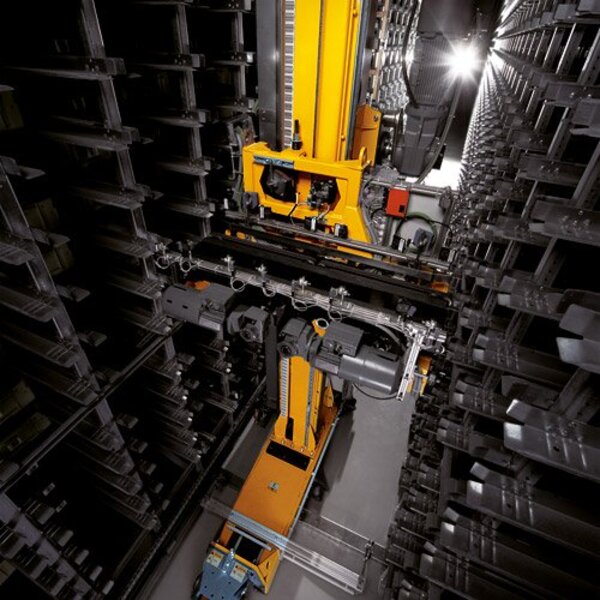
This is why you might hear them referred to as “tote-stacking” or “case-handling” systems.
Overall, a mini-load ASRS system is ideal for limited floor space operations with a lot of SKUs to store.
Now, not all mini-load ASRS systems are the same.
In fact, there are several automated storage and retrieval system examples, including:
- Shuttles
- Horizontal and vertical carousels
- Vertical lift modules (VLMs)
- Cube-based storage
Let’s explain what each one is.
Shuttles
Shuttles are robotic equipment used to handle cartons, trays, and totes.
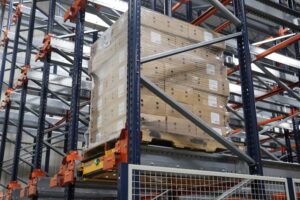
Essentially, they serve as carriers to bring totes, cartons or pallets to whichever workstation they’re needed.
And impressively, they can operate on single or multiple levels to get the job done.
Horizontal and Vertical Carousels
A carousel-based ASRS is designed to handle small items using bins.
Carousels can be horizontal (like a merry-go-round):
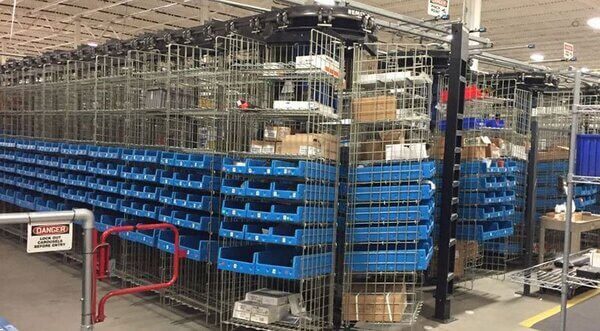
Or vertical (like a Ferris wheel).
In either design, bins are held within a rotating rack system on the carousel.
When a worker needs a particular bin, they simply select it from the carousel.
And workers know which bin to choose from when the carousel lightree indicates the location.
Vertical Lift Modules (VLMs)
Sometimes called an “automated vertical storage system”, VLMs are enclosed, automatic systems with inserters or extractors in between columns of trays.
When a worker needs an item, the machine:
- Retrieves the tray
- Delivers it to the worker
- And replaces the tray in the column
Cube-Based Storage
In cube-based storage, items are stored in bins.
And these bins are placed within a grid of cubes.
Robot pickers travel on top of the cube grid, picking bins and bringing them to workstations.
Typically, cube-based storage is used within a goods-to-person system, which we’ll cover below.
ASRS System Configurations: 4 Types Explained
You now know the various pieces of equipment that are involved in ASRS systems.
But not all this equipment is used in the same way.
By that, we mean that ASRS systems can be set up in a variety of ways, using a combination of the equipment detailed above, depending on the needs of the operation.
So let’s go through 4 of those configurations.
1. Goods-to-Person
In a traditional warehouse, workers pick and pack items while physically moving from one storage location to another.
But all that back and forth is time-consuming.
Thankfully, an ASRS system can replace this activity.
How exactly?
In a goods-to-person ASRS setup, automated equipment does this movement instead.
That is, the equipment acts as a storage retrieval device, bringing goods to the person instead of the person going to the goods.
And using this process can cut the time required for order picking and packing by up to 50%.
2. Order Staging
Some warehouses – especially those that handle e-commerce orders – are under pressure to keep up with 24/7 orders and sales.
And much of this involves staging orders when they’re packed and ready for shipping.
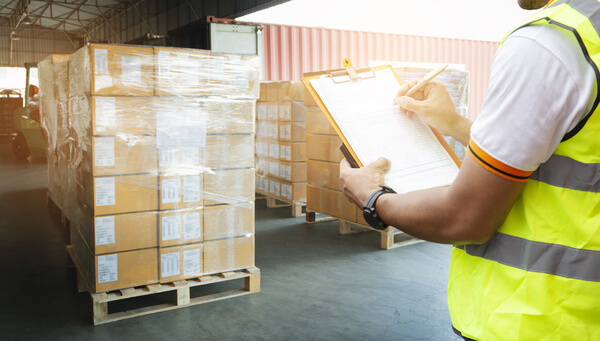
But this isn’t easy to accomplish manually due to shift changes and weekend shutdowns.
And that’s where ASRS can help.
By using these systems, warehouses can automatically stage orders.
Then, they can be shipped out once staff and trucks are available.
3. Material Storage
Depending on the products handled, warehouses can have many specific inventory storage needs.
For example, there may be a need to turn products around within a certain time.
This is common in the Last-In, First-Out (LIFO) inventory management method.
But ensuring products make it out before expiring is difficult to do manually.
And that’s where an ASRS system – in combination with a warehouse management system – can help.
The WMS keeps track of when items are due to expire.
And the ASRS equipment will automatically retrieve those items when the correct time comes.
4. Supply Replenishment
It’s common for warehouse operations to require a continuous supply of materials to keep things flowing.
For example, assembly lines may require a steady supply of components so they can be fitted together to make the final product.
But ensuring this steady supply can be a challenge to do manually.
ASRS can help by managing this continuous flow of materials needed for operations.
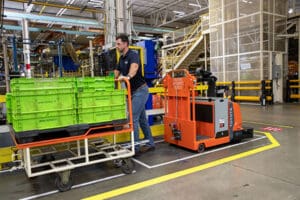
They can perform several tasks, including:
-
Staging materials as they arrive
-
Delivering materials needed for assembly
-
Consolidating orders for shipping
What Are the Benefits of Automatic Storage and Retrieval Systems?
Now that you understand what ASRS systems are, as well as the different types and ways they can be set up, let’s go through some of the advantages of using them.
Reduces Labor Costs
In a warehouse, labor is both difficult to find and generally expensive.
In fact, labor costs account for 60 to 65% of a warehouse’s total budget.
And much of a warehouse’s labor involves traveling and picking.
That is, workers traveling from SKU to SKU retrieving items and taking the time to ensure they’re picking the right ones.
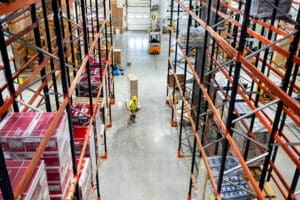
And automating order fulfillment with ASRS can help reduce reliance on labor.
Of course, this is done by replacing the manual aspect of warehousing tasks with automatic systems.
And in doing so, ASRS systems can use 2/3 less labor than in a manual warehouse operation.
Boosts Productivity
Unlike humans, robots don’t take breaks.
In fact, they can work in 24/7 operations without interruption.
And since ASRS systems use robotics, this enables operations to achieve huge gains in productivity.
While ASRS systems may not handle all warehousing tasks, they can still help boost productivity by allowing workers to pick orders faster.
Improves Safety
Humans make mistakes.
And sometimes mistakes can result in safety concerns.
This is especially the case when mistakes are made when operating heavy and powerful material handling equipment.
But incorporating automated tech can help reduce these mistakes.
As a result, operations using ASRS systems can reduce the risk of injury and improve employee safety.
Minimizes Mistakes
Not only are mistakes potentially dangerous to workers, but they can also hurt the bottom line.
When a worker picks or packs the wrong item, customers get upset and costs rise.
But ASRS machines are extremely accurate: They know exactly what to pick, where to pick it, and how much to pick.
In fact, this can mean achieving 99.9% pick accuracy.
And this results in happier customers and lower costs.
Increases Storage Space
Warehouses are handling more and more items every year.
And space is at a premium – and expensive to increase.
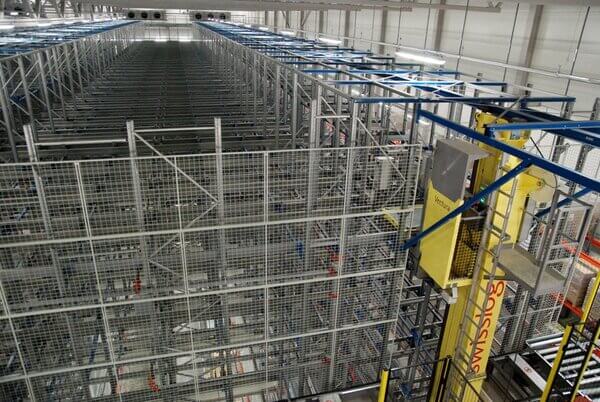
So how can ASRS systems help?
By making better use of floor space through their small footprints as well as vertical space by expanding storage upwards.
And this can help save up to 85% of floor space.
Improves Inventory Management
ASRS systems are often integrated with warehouse management systems to provide greater inventory control.
And ASRS solutions allow for more accurate insight into the state of inventory.
This is because using an ASRS system lets you know what you have and where it is.
And this reduces the chances of missing stock and all the costs that go along with it.
Reduces Issues with Difficult Work Environments
Hot or cold environments can fatigue workers and sometimes cause health problems.
But of course, robots don’t have to deal with the rigors of these environments.
Consequently, using ASRS technology can alleviate the difficulties associated with working in these environments.
And in doing so, they can help and create a safe and ergonomic working environment for employees.
Improves Operational Flexibility
Warehouses don’t always stay the same.
For example, when there’s high demand, you may need more throughput to cope.
And therein lies a key benefit of ASRS systems: They’re modular.
That means you can expand and configure them to accommodate your growth as well as any changes in the materials or products you’re handling.
This way, you can limit the initial expense of large-scale automation and slowly transition to full automation.
How Much Does an Automated Storage and Retrieval System Cost?
The costs for ASRS systems vary depending on what you need, your operation, and your industry.
The general factors that determine the average cost of ASRS systems include:
-
The cost of ASRS technology equipment itself and any accompanying software, shipping or delivery costs, and installation costs
-
Your available storage space
-
The size and weight of your products
-
The features of your operating environment, including heat, ambient temperature, refrigerated/freezer, etc.
-
The cost of your facility’s custom configurations to maximize ASRS usability
-
Any ongoing costs, like labor costs for implementation, maintenance of the ASRS system, and training to use the ASRS system
So, how much do ASRS systems cost?
Some costs of the most common ASRS include:
Although they can be expensive, ASRS systems can have an ROI of under 18 months because of their space, labor, and picking efficiencies.
And the good news is that you can start with lower-cost options and expand from there.
For a clearer idea of what you need and what it’ll cost, give us a call!
What Companies Use ASRS?
ASRS technology has really taken off in recent years.
So if you’re wondering who uses them, here are 3 companies:
Best Buy
Best Buy has become a leader in the e-commerce space in recent years.
And with that rise has come many challenges.
One such challenge is their ability to cope with increased orders in a fast-paced environment where customers have plenty of alternatives.
The solution for Best Buy was to use an “AutoStore” concept featuring a:
- Goods-to-person order picking system
- Cube-based storage system
With 840,000 bin locations and over 1,000 robots, Best Buy has greatly boosted its order fulfillment capabilities.
Now, they can offer free next-day delivery for over 50 million orders.
See how Best Buy’s system works in this short video:
Epson
Faced with a rapidly growing product supply business, Epson needed to expand distribution and increase throughput.
Epson now uses horizontal carousels whose components include:
- 7 horizontal carousels on an 8,600 ft. conveyor
- 4 single-level pick modules
With this technology, Epson has seen excellent improvements in its operations.
This includes a 7% reduction in labor costs and a 28% increase in throughput.
PUMA
Trying to cope with increasing same-day order fulfillment needs and peak seasonal demands, PUMA needed to improve its operational efficiency.
Like Best Buy, PUMA now uses the “AutoStore” concept, including a:
- Goods-to-person order picking system
- Cube-based storage system
With 170 robots and 171,000 bin locations, PUMA can now manage up to 200 e-commerce lines per hour.
Check out how ASRS helped PUMA in this short video:
Conclusion
That’s it: Everything you need to know about automated storage and retrieval systems.
